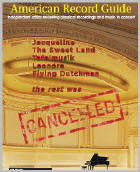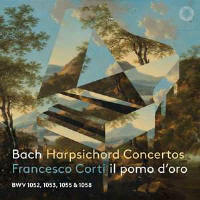Reviewer: Bradley
Lehman
This lively recording was made
in March 2019 in Toblach, a small town in the Italian mountains near the
border of Austria. It's the same idyllic place where Gustav Mahler had a
secluded cabin to compose his ninth symphony and Das Lied von der Erde—get
out of the cities and do great work. I suspect that most readers will
already have as many recordings of the Bach concertos as they want, and
played on whatever combinations of instruments they prefer to listen to (not
necessarily harpsichords or pianos). The music is core repertoire everyone
knows, and playing it is a standard test of professional dexterity and
musicianship. Polished perfection is an assumed baseline, though not always
delivered. So, why bother looking at another one?
This one is worth your attention and money. Francesco Corti and "The Golden
Apple" make the music vivid and fresh. Ornamentation is moderate and sounds
truly extemporaneous. When he inserts small pauses to set phrases apart, or
tiny improvised cadenzas, the band alertly stays with him and in perfect
unison with each other. There are some audible intakes of breath by either
Corti or the concertmaster helping with the cohesion. The highest
concentration of added notes is in the exhilarating finales of Concertos 2
and 7. Is all of this a rehearsed pseudo–spontaneity, or just great
listening across the space? Many recordings of Bach's music are now made
with only one string player per part, and I concur that it's a plausible
historical solution. (Balance is sufficient, it would take extra time to
copy out more parts, multiple copies of surviving parts are rare, and
engaging extra players has always been a higher expense unless you can get
them as unpaid amateurs.) This performance employs more instruments: 6
violins, 2 violas, a cello, a bass, and a second harpsichord. Lars–Ulrik
Mortensen and Concerto Copenhagen (CPO, M/A 2004 & J/F 2007) had yet a few
more musicians than this, sounding similar. In Corti's recording of Concerto
4 it's easier to hear the harpsichord than it is in Mortensen's. That's
partly Bach's fault for setting the melodic lines so low in the range. In
2017 and 2018 I reviewed some other recordings with smaller or larger
orchestras than this. The longest overview of those was for one–per–part
performances (N/D 2018). I've given up trying to judge what is "best" at
levels of achievement this high for midsized orchestras (both Mortensen and
Corti). Get Corti's and enjoy it as a beautiful celebration of perfect
expertise. Play it loud and dance around your room. Watch for this band to
get to Volume 2 with the remaining three or four concertos—assuming that the
music world can someday get out of pandemic lockdown and back to playing
this well for appreciative audiences.
Fermer la fenêtre/Close window
|




